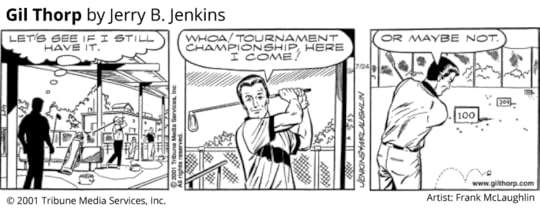What Writing a Story Strip Taught Me

I was working on one of the Left Behind novels in the mid-90s when I took a call from a childhood hero of mine.
When he introduced himself, I blurted, “The Jack Berrill of Gil Thorp fame?”
I told him I had been a fan of his daily newspaper sports story strip since childhood and still read it every day.
Mr. Berrill had created Gil Thorp in 1958, naming his title character after baseball player Gil Hodges and Olympian Jim Thorpe. Gil Thorp was athletics director and head football, basketball, and baseball coach at Milford High. The strip was carried by hundreds of newspapers throughout the U.S.
The aging Mr. Berrill (who tried in vain to get me to call him Jack—I just couldn’t) said he had happened upon several sports books I had written and wondered if I would consider writing a series of Gil Thorp books.
Getting Acquainted
My plate was more than full, but this intrigued me. Over the better part of the next year, Mr. Berrill and I chatted by phone probably a half dozen times, noodling the possibilities.
We somehow seemed to connect personally too. I told him I was impressed that he both wrote and drew the stories and asked how he made the strip so addictive.
Mr. Berrill’s Secret Formula
“It’s embarrassingly easy, actually,” he said. “The first panel reminds readers what the story is about. The second moves the story along. The third I design to make them just have to come back tomorrow.”
He also said he tried to tell as much of the story visually as possible, so the blocks of dialogue could be crisp and didn’t have to do a lot of “telling.”
The Sad News, and the Offer
Early in 1996, I stopped hearing from him, then noticed a small item in the paper that said he was ailing and that Tribune Media Services (the syndicate that distributed Gil Thorp) was temporarily rerunning old strips.
In March, a man from Tribune Media Services called to tell me Mr. Berrill had died of cancer. That saddened me, of course, and I regretted never having met the man.
“He left word he wanted you to take over the strip.”
”Oh, surely not,” I said. “He never mentioned that.”
A few days later I heard from his widow, who confirmed his wish. “He was fond of you. He felt you understood him.”
The Work
Honored beyond words, but not certain my skill set jibed with a sports story strip, I met with the Tribune Media Services man.
“I hope you’re not counting on me to also be the artist,” I said. “I couldn’t draw a gun.”
He assured me that the artist capable of imitating Jack Berrill’s work, who had filled in for him occasionally over the years, had already signed on.
He also informed me they would need a certain number of scripts every quarter that would consist of several self-contained stories, including detailed descriptions of what I wanted the artist to draw for each of the three panels every day, along with the dialogue.
Its Effect
For the next eight years, I did all I could to honor Jack Berrill’s legacy and do justice to his creation.
Writing novels and writing a story script are as different as prose and poetry. Every aspect of Gil Thorp had to be distilled to its bare minimum. What I remember most about those years—besides involving my three sons in coming up with story ideas—is cutting, cutting, cutting.
I strived every day to meticulously describe my vision for the artist while chopping dialogue to the bone.
That discipline became a refreshing break from the grueling ordeal of novel writing, yet I found it informed the whole of my career as a fiction writer. It continues to do so to this day.
No throat-clearing, no elaborate scene-setting, no flashbacks—just get after the story, get it down, and get out.
What Mr. Berrill taught me about the simple functions of each panel carried me through my learning curve and remain the blueprint for Gil Thorp to this day, though it has had a new writer/artist team for a dozen years.
It’s hard to believe we’re only a couple of years from the 60th anniversary of Jack Berrill’s first episode of Gil Thorp. I’ll celebrate that, not only because of his colossal creativity and talent, but also because of what it meant to me and my craft.
Can you apply the techniques I learned from Jack Berrill to your next piece of writing? Tell me how in the Comments below.
The post What Writing a Story Strip Taught Me appeared first on Jerry Jenkins | Write Your Book.



